As promised, I tell you now my thoughts on HISTORY Channel’s Sons of Liberty. As I said in the earlier post, this 3-episode series made me cry. The question “Why?” just kept ringing in my head. Why had the producers made the choices they made? The likely answer is ratings, I suppose.
Though, it would seem that a venue titled HISTORY Channel might give more thought to the actual history than, say, HBO. And this brings up the elephant in the room: if we know that the portrayal of April 19, 1775 was so “fabricated” for the viewing public, that it cannot be trusted as History, then is anything we see on this so-called “HISTORY” Channel any more reliable?
But I digress.
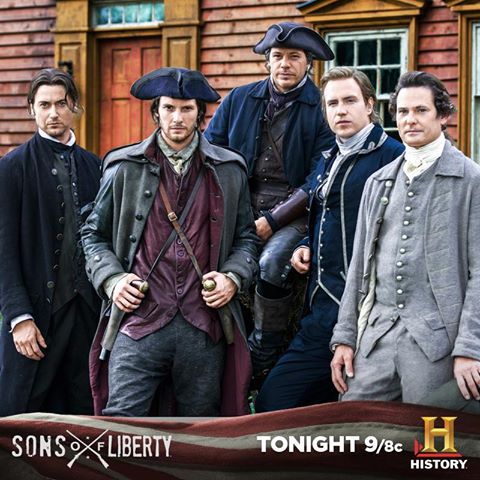 For this post, I’ll mutter a bit about the Sons of Liberty portrayal of the night of April 18th and the early parts of April 19th – up through the “Battle” of Lexington Green.
For this post, I’ll mutter a bit about the Sons of Liberty portrayal of the night of April 18th and the early parts of April 19th – up through the “Battle” of Lexington Green.
Dr. Joseph Warren – philanderer?
First of all, let me mention that I don’t believe for a minute that Margaret Gage was sleeping with Dr. Joseph Warren. Now, I suppose it’s possible but I imagine this was just a let’s-throw-some-sex-in-here decision by the writers/producers. (Much like we see in the series Turn.) Though, of course, there was bound to be illicit sex in Colonial America, let’s face it; these people, for the most part were pretty religious. Sam Adams and John Hancock, for that matter were very religious men – just read their writings.
Dr. Warren was the head of the Sons of Liberty in Boston. He was dedicated to a cause. Besides that, he’d lost his wife in 1772 (leaving behind four children) and sources say that he was desperately sad – to the point of being self-destructive. Does that mean that he didn’t have a dalliance with the Royal Governor’s wife? No. But I do doubt it.
Revere and Dawes – on the road again . . .
Then there’s Paul Revere and William Dawes. I give SoL credit that they included Dawes in the ride to alert the countryside. But there were a few problems that I picked out on this issue. (Let me say, though, that these are really very minor issues and I might be silly to even bring them up.) It is doubtful that Dawes and Revere had conversations in the days before the ride. The whole Sons of Liberty/spying thing was pretty secretive. They likely hadn’t met until they were both at the Clarke House in Lexington.
Revere didn’t ride out of Boston. He was rowed across Back Bay, in the shadow of the HMS Somerset, to Charleston, where he was met by Patriots who loaned him a horse. It was Deacon Larkin’s father’s horse – said to be the fastest horse in the region. And the good Deacon wouldn’t get his dad’s horse back.
Revere gets his fight on . . .
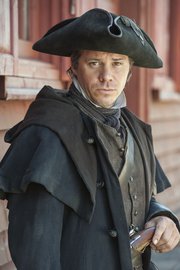 In the series, there’s a fight scene between Revere and a Redcoat patrol that tries to stop him from alerting the countryside. Revere did run into a patrol on the road to Lexington but he was able to evade them with Brown Beauty’s speed. But I did like this scene – which could have been inserted later and been more accurate. When Revere is asked who he is, he answers “I’m a colonial scout for an armed resistance against the tyranny of General Gage and the British Crown.” The Redcoat says “Really” – totally unconvinced. But it was a great line and made me smile. And, frankly, I really liked their version of Revere. He was a real fighter. I like that in a Revolutionary War Hero. More about the “Paul Revere Show” in another post.
In the series, there’s a fight scene between Revere and a Redcoat patrol that tries to stop him from alerting the countryside. Revere did run into a patrol on the road to Lexington but he was able to evade them with Brown Beauty’s speed. But I did like this scene – which could have been inserted later and been more accurate. When Revere is asked who he is, he answers “I’m a colonial scout for an armed resistance against the tyranny of General Gage and the British Crown.” The Redcoat says “Really” – totally unconvinced. But it was a great line and made me smile. And, frankly, I really liked their version of Revere. He was a real fighter. I like that in a Revolutionary War Hero. More about the “Paul Revere Show” in another post.
Revere arrived in Lexington at around midnight – not in the full light of day as in the series. In the show, he busts into a small house where Adams and Hancock are staying and warns them that they need to flee to safety. Sam Adams wants to stay and fight – this part is true. But the bit with Revere causing a diversion so Adams and Hancock could get away was purely made up.
Hancock and Adams at the preachers house – and a fiancee?
Hancock and Adams were staying at the home of the Reverend Jonas Clarke – Lexington’s firebrand preacher. Jonas Clarke succeeded the Reverend John Hancock (our John Hancock’s grandfather) as preacher in Lexington. Our John Hancock spent a lot of time there as a child and young man so he was a very familiar face in Lexington. Also staying at the Clarke home was Dolly Quincy, Hancock’s fiancee. It was only after Revere’s capture, his release and his walk back to Lexington that he was able to convince Adams and Hancock to load up the carriage and get to safety. Of course, John took Dolly along as well.
Point of fact – Revere didn’t make it. . .
And finally, here’s the most important HISTORY that the HISTORY channel screwed up. Paul Revere never made it to Concord. He and Dawes left the Clarke home about 1am, headed to warn Concord. Along the road they met Samuel Prescott, the young doctor from Concord and also a High Son of Liberty. The three of them rode together, but were captured by a Redcoat patrol in Lincoln. Dawes and Prescott got away. Dawes was unhorsed in the escape and walked back to Lexington. Prescott got clean away and was the one that warned Concord.
Revere was let go about two hours later – and there’s a great story there which I’ll have to tell another time. The Redcoats kept Brown Beauty and legend has it that they rode her to death. But this brings up the point that I often make: April 18th and 19th, 1775 were so filled with TRUE drama that a self-respecting HISTORY Channel would not have to make stories up.
Well, I certainly didn’t mean this post to be this long. And I thought I could get through the HISTORY Channels portrayal of events on Lexington Green. Alas, no. That will have to wait till next time.
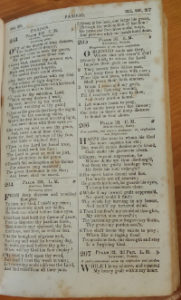 Isaac Watts was born in England in 1674 and died in 1748. He was a popular hymn writer, considering hymns a tool for evangelization. He was a nonconformist and thus, was not allowed to attend Anglican universities Oxford or Cambridge.
Isaac Watts was born in England in 1674 and died in 1748. He was a popular hymn writer, considering hymns a tool for evangelization. He was a nonconformist and thus, was not allowed to attend Anglican universities Oxford or Cambridge.
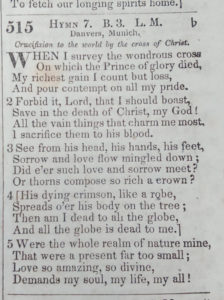

 The Green Mountain Boys, under the command of Ethan Allen marched under this flag. This militia group was from the New Hampshire Grants that later became Vermont. This militia formed to protect their land grants which were granted by New Hampshire. The British government officially gave them to New York. So, when New York attempted to take control of their lands, the Green Mountain Boys militia was born. On several occasions, Ethan Allen and his boys repelled attempts to take their land.
The Green Mountain Boys, under the command of Ethan Allen marched under this flag. This militia group was from the New Hampshire Grants that later became Vermont. This militia formed to protect their land grants which were granted by New Hampshire. The British government officially gave them to New York. So, when New York attempted to take control of their lands, the Green Mountain Boys militia was born. On several occasions, Ethan Allen and his boys repelled attempts to take their land.
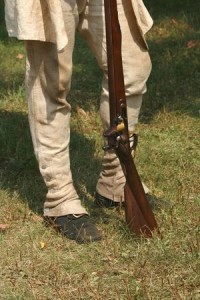 Nathaniel Mulliken. Clockmaker. Lexington, MA.
Nathaniel Mulliken. Clockmaker. Lexington, MA.
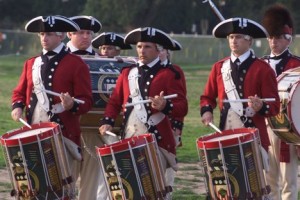
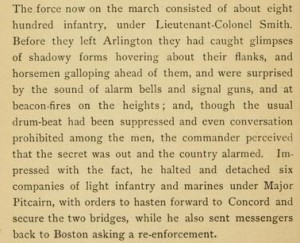
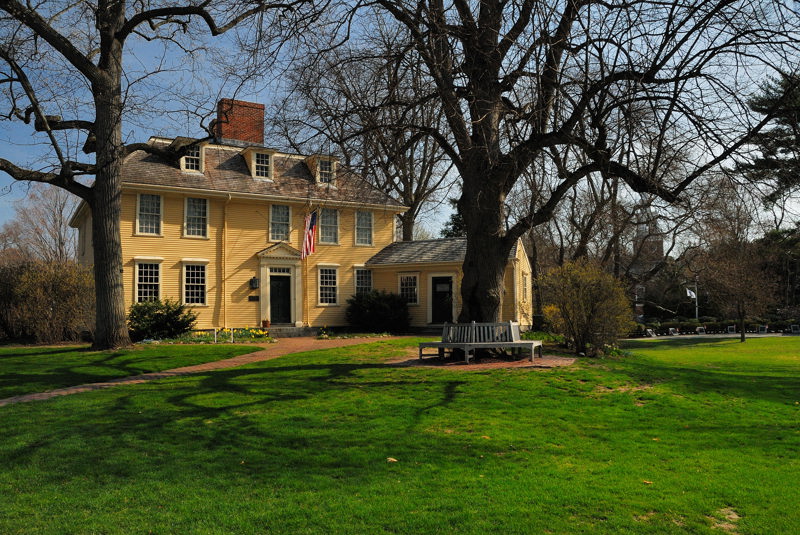 "Grandfather Brown," she says, "told me this story :
"Grandfather Brown," she says, "told me this story : Specifically, I have been seeking the names of the Acton Minutemen that marched early on the morning of April 19th to join their brothers-in-arms on Punkatassett Hill in Concord.
Specifically, I have been seeking the names of the Acton Minutemen that marched early on the morning of April 19th to join their brothers-in-arms on Punkatassett Hill in Concord.  But. . . just before conference began I realized that it’s been over a year since I had a finished product to show to the world. A WHOLE YEAR???? That is not acceptable for the journeyman writer (hat tip
But. . . just before conference began I realized that it’s been over a year since I had a finished product to show to the world. A WHOLE YEAR???? That is not acceptable for the journeyman writer (hat tip
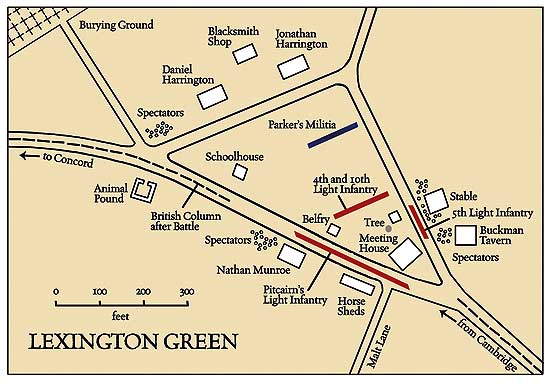
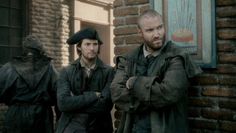 Before I go further though, throughout this silly series, we see the same characters just moving from place to place as the day progresses. Here, on the Green, we see this MAN OF LEXINGTON who is the focus of the scene. In the series, he’s one of Sam Adam’s buds named Kelly. He leads the Lexington men, gives them their order not to shoot first, then becomes a martyr to Pitcairn’s torture. Balderdash!!!
Before I go further though, throughout this silly series, we see the same characters just moving from place to place as the day progresses. Here, on the Green, we see this MAN OF LEXINGTON who is the focus of the scene. In the series, he’s one of Sam Adam’s buds named Kelly. He leads the Lexington men, gives them their order not to shoot first, then becomes a martyr to Pitcairn’s torture. Balderdash!!! For this post, I’ll mutter a bit about the Sons of Liberty portrayal of the night of April 18th and the early parts of April 19th – up through the “Battle” of Lexington Green.
For this post, I’ll mutter a bit about the Sons of Liberty portrayal of the night of April 18th and the early parts of April 19th – up through the “Battle” of Lexington Green. In the series, there’s a fight scene between Revere and a Redcoat patrol that tries to stop him from alerting the countryside. Revere did run into a patrol on the road to Lexington but he was able to evade them with Brown Beauty’s speed. But I did like this scene – which could have been inserted later and been more accurate. When Revere is asked who he is, he answers “I’m a colonial scout for an armed resistance against the tyranny of General Gage and the British Crown.” The Redcoat says “Really” – totally unconvinced. But it was a great line and made me smile. And, frankly, I really liked their version of Revere. He was a real fighter. I like that in a Revolutionary War Hero. More about the “Paul Revere Show” in another post.
In the series, there’s a fight scene between Revere and a Redcoat patrol that tries to stop him from alerting the countryside. Revere did run into a patrol on the road to Lexington but he was able to evade them with Brown Beauty’s speed. But I did like this scene – which could have been inserted later and been more accurate. When Revere is asked who he is, he answers “I’m a colonial scout for an armed resistance against the tyranny of General Gage and the British Crown.” The Redcoat says “Really” – totally unconvinced. But it was a great line and made me smile. And, frankly, I really liked their version of Revere. He was a real fighter. I like that in a Revolutionary War Hero. More about the “Paul Revere Show” in another post.